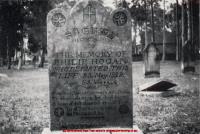JMF genealogy

Person Page 3,203
Philip Hogan
b. 1766, d. 22 May 1829
Person Exhibits

The gravestone of Philip Hogan, c1766 - 1829.
Birth
Family life
Philip Hogan and Mary McMahon were married on 26 March 1810 at Parish of St John's in Parramatta.1,4,5,6,7
Children with Mary McMahon (b. 1777, d. 7 September 1859)
| Son | Michael Hogan+ (b. 1805, d. about 1841) |
| Daughter | Catherine Hogan+ (b. 1807, d. 19 September 1865) |
| Son | Robert Hogan (b. about 1808, d. about 1842) |
| Son | James Hogan (b. 1809) |
| Son | Henry Hogan+ (b. 1814, d. 26 October 1865) |
| Daughter | Margaret Hogan+ (b. 1816, d. 1 April 1887) |
| Son | John Hogan+ (b. 1817, d. 17 April 1881) |
| Daughter | Mary Hogan (b. 1819) |
| Son | Denis Hogan+ (b. 1820, d. 13 March 1866) |
| Daughter | Bridget Hogan+ (b. 1824, d. 21 July 1891) |
Residence information
Philip Hogan lived at SS Friendship 2 in Cork, Ireland, on 15 July 1799.8 He emigrated on 24 August 1799 from Cork, Ireland. The Friendship sailed along with the convict ship Minerva within in a large convoy of ships that were bound for America and the West Indies. The convoy was led by HMS Dryad and HMS Revolutionnaire. The ships of the convoy went their separate ways after three days. The Friendship and Minerva parted company on 14 September. A week later three convicts died a fever that spread rapidly throughout the ship. But, thanks to the captain's benevolent actions, most people recovered quickly.8 He lived in St Helena on 30 October 1799, aboard the convict ship Friendship 2. The ship remained at St Helena for two weeks during which the prisoners were inspected by Henry Wellesley who was en route from India to England bringing details of the British Army's defeat at Seringapatam. (Wellesley was a younger brother of Arthur Wellesley who had fought in that battle and who was to command the British forces that defeated Naploeon at Waterloo in 1815; Arthur was made first Duke of Wellington and subsequently served two terms as British Prime Minister.) Henry Wellesley was interested to see the calibre of the men who had participated in the Irish Rebellion of 1798. During his inspection he recognised and spoke to convict Matthew Sutton, a childhood friend. Sutton was so ashamed of his predicament that he refused to stand or to engage Wellesley in conversation. It may have been Henry Wellesley who suggested to his brother after Napoleon's surrender at Waterloo that St Helena might make a good prison for Napoleon.8 He lived in Capetown, South Africa, on 7 December 1799, aboard the convict ship Friendship 2. The ship remained at the Cape for a fortnight, departing Table Bay on Christmas Day.8 He immigrated in 1800. SS "Friendship"1 He immigrated on 17 February 1800 to Sydney, NSW, Australia. The convicts were disembarked four days later. According to the diary of Captain Reed's wife, "many of them left the ship with tears, and each boat-load cheered as they put off, which was rather a novel sight to many on shore, who had received harsh treatment on their passage out. The captain received a letter from the Governor, expressing his thanks and approbation for the kind treatment and good management during the passage, saying, that such conduct would not be forgot in the dispatches to the Lords Commissioners of the Admiralty."8 He lived in Parramatta, NSW, Australia, in August 1806.9 He lived in February 1811.10 He granted 40 acres of land by Governor Macquarie on 14 June 1811 in South Creek.11,12 He lived in September 1816.13 He lived in 1817.14 He lived in 1818.15 He granted 120 acres by Governor Macquarie on 13 January 1818 in Bringelly. The land was "bounded on the S by Nicholas Ham Farm; bearing E 55 chains 65 auks commencing at the Ponds; on the E by a xxx of 24 chains 50 auks to Reynolds SE corner; on the N by Reynolds Farm bearing xx 40 chains 30 auks to the Ponds; and on the W by those Ponds". The land was granted on condition that he was "not to sell or alienate the same for the space of 5 years from the date hereof and to cultivate 22 acres within the said period, and reserving to Government the right of making a Public Road through the same, and also reserving for the use of the Crown such timber as may be deemed fit for Naval Purposes". There was an annual Quit Rent of 3 shillings commencing at the end of 5 years.16,17 He lived in October 1819.18 He lived in September 1820.19 He granted 50 acres of land by Gov MacQuarie on 31 March 1821 in Medway Rivulet. The land was between the present-day villages of Sutton Forest and Berrima. The land was described as "bounded on the North West by Michael Hogan's farm bearing W40 South; on the South West by a line bearing S40E 10 chains 50 links; on the South East 40 North 55 chains to the Medway Rivulet; and on the North East by that Rivulet. His son, Michael, had the adjacent 60 acres. The land was granted on the condition that he was "to clear and cultivate 15 acres within a term of 5 years, not to sell, alienate, assign, transfer or set over until the said term, reserving to Government the Right of making Public Roads through the same, also the right of such timber as may be deemed fit for Naval Purposes". There was an annual Quit Rent of 1 shilling commencing at the end of 5 years.20,21,22,23,24 He lived in September 1821.25 He was granted land in 1822 in Cosgroves Creek. obtained land called "Claremont"20 He lived in Liverpool, NSW, in 1822.26 He was granted 30 acres in 1822 in Cooks Vale Creek.27,28,29 He lived in Bringelly, NSW, Australia, in September 1823.30 He granted 30 acres in 1825 in Georgiana.31
Involvement in crime
Philip Hogan was tried in 1797 in Clonmel. He was sentenced to transportation for life.3 He was holding a ticket of leave in 1806 in Parramatta.9 He was granted a Ticket of Leave on 19 January 1811 in Parramatta.32 He was granted a Ticket of Leave on 19 March 1811 in Parramatta.33 He was granted a Conditional Pardon on 22 July 1811 in Parramatta.32,34
Working life
Death
Memorial
There is a memorial to Philip Hogan at St Patrick's cemetery in Parramatta, New South Wales, Australia. Follow this link for information and images of his memorial.
Citations
- [S465] "RR: Hogan-McMahon Descendants Chart", unknown author; Fleming Family History Archive, Sydney.
- [S466] "RR: Hanrahan-Hogan Descendants Chart", unknown author; Fleming Family History Archive, Sydney.
- [S910] Philip Hogan, Convict Indent 1800 NSW: Hogan Philip, (Kingswood NSW: NSW State Archives), Arrived 16 Feb 1800, Friendship 2. Master: Hugh Reed.
- [S467] GM Cashman, Avoca, The Faith of the Pioneers, Black Springs: The Centenary Committee of the Church of St Vincent de Paul, 1988, p 9.
- [S954] Marriage Certificate, Philip Hogan and Mary McMahon, 26 March 1810, Registry of Births Deaths and Marriages, NSW. No 432 Vol 147A.
- [S956] Marriage Certificate, Philip Hogan and Mary McMahon, 26 March 1810, Society of Australian Genealogists, NSW. No 296 p77; SAG Reel 55.
- [S966] Death Certificate, Mary White nee McMahon, Registry of Births Deaths and Marriages, NSW, 3343/1859.
- [S943] Captain Hugh Reed's wife, Diary of Captain Hugh Reed's wife aboard Friendship 2 in 1799, Captain Hugh Reed's wife: Manuscript, 1799.
- [S911] Philip Hogan, Convict Muster 1806 NSW: Hogan Philip, (Kingswood NSW: NSW State Archives), 1806. Parramatta.
- [S912] Philip Hogan, Convict Muster 1811 NSW: Hogan Philip, (Kingswood NSW: NSW State Archives), 1811
- [S915] Deed: Land Grant Register 40 ac Hawkesbury Gov Macquarie - Philip Hogan, Archives Office of NSW, Land Grant Register.
- [S917] Deed: Land Grant Register 40 ac South Creek Gov Macquarie - Philip Hogan, Archives Office of NSW, Colonial Secretary Register.
- [S919] Philip Hogan, Convict Muster 1816 NSW: Hogan Philip, (Kingswood NSW: NSW State Archives), 1816
- [S920] Philip Hogan, Convict Muster 1817 NSW: Hogan Philip, (Kingswood NSW: NSW State Archives), 1817
- [S921] Philip Hogan, Convict Muster 1818 NSW: Hogan Philip, (Kingswood NSW: NSW State Archives), 1818
- [S922] Deed: Land Grant 120 ac Bringelly Gov Macquarie - Philip Hogan, Archives Office of NSW, Colonial Secretary Register.
- [S938] Deed: Land Grant 120 ac Bringelly Gov Macquarie - Philip Hogan, Archives Office of NSW, Colonial Secretary Register.
- [S923] Philip Hogan, Convict Muster 1819 NSW: Hogan Philip, (Kingswood NSW: NSW State Archives), 1819
- [S924] Philip Hogan, Convict Muster 1820 NSW: Hogan Philip, (Kingswood NSW: NSW State Archives), 1820
- [S467] GM Cashman, Avoca, The Faith of the Pioneers, Black Springs: The Centenary Committee of the Church of St Vincent de Paul, 1988, p11.
- [S926] Deed: Land Grant Register 50 ac Sutton Forest Gov Macquarie - Philip Hogan, Archives Office of NSW, Colonial Secretary Register.
- [S927] Deed: Land Grant Register 50 ac Sutton Forest Gov Macquarie - Philip Hogan, Archives Office of NSW, Colonial Secretary Register.
- [S937] Deed: Land Grant 50 ac Sutton Forest Gov Brisbane- Philip Hogan, Archives Office of NSW, Colonial Secretary Register.
- [S940] Surveyor-General's Office, Sydney Gazette & NSW Advertiser, 28 Apr 1821, p1.
- [S925] Philip Hogan, Convict Muster 1821 NSW: Hogan Philip, (Kingswood NSW: NSW State Archives), 1821
- [S928] Philip Hogan, Convict Muster 1822 NSW: Hogan Philip, (Kingswood NSW: NSW State Archives), 1822, Liverpool Population Book
- [S933] Deed: Land Grant Register 30 ac Cooks Vale Creek Gov Macquarie - Philip Hogan, Archives Office of NSW, Colonial Secretary Register.
- [S941] Surveyor-General's Office, Sydney Gazette & NSW Advertiser, 1 Jan 1823, p1.
- [S942] Surveyor-General's Office, Sydney Gazette & NSW Advertiser, 26 May 1824, p1.
- [S932] Hogan family, Convict and Settlers List 1825 NSW: Hogan family, (Kingswood NSW: NSW State Archives), 1825
- [S934] Deed: Land Grant Register 30 ac Georgiana Gov ? - Philip Hogan, Archives Office of NSW, Colonial Secretary Register.
- [S913] Philip Hogan, ToL: Philip Hogan 1811, (NSW: Tickets of Leave Register), 19 Jan 1811, 6/220. Parramatta.
- [S914] Philip Hogan, ToL: Philip Hogan 19/3/1811, (NSW: Tickets of Leave Register), 19 Mar 1811, 239/453. Parramatta.
- [S916] Philip Hogan, Conditional Pardon, (NSW: Colonial Secretary), 22 Jul 1811. Conditional Pardon register.
- [S930] Philip Hogan, Convict Muster 1825 NSW: Hogan Philip, (Kingswood NSW: NSW State Archives), 1825
| Context | Ch forebears Ch Kessey forebears Convicts Pedigree Hanrahan Pedigree Kessey |
| Last Edited | 29 June 2022 |